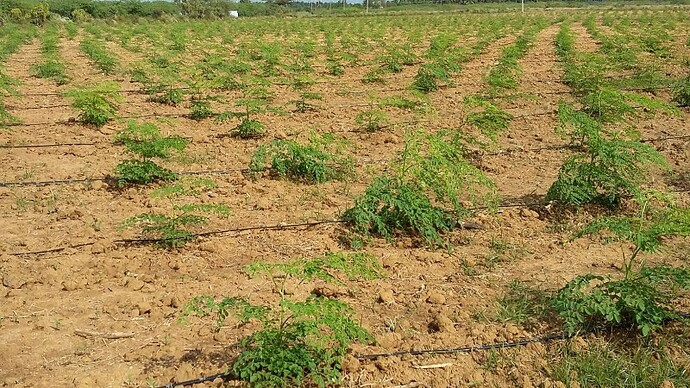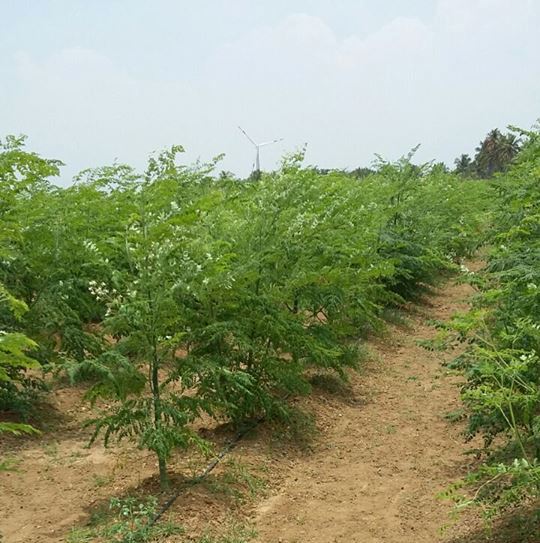Seed rate – 500 grams per acre
Spacing - 2.5 meter row to row and 1.80 M plant to plant distance along the rows
No of plants per acre – 4000 / 2.5 M* 1.80 M = 888 plants
Season of planting – June – July
Pit size – 45 cms length 45 cms width 45 cms depth pit is made ( if soil is black and clay soil ) for easy growth and development of roots
Manure – 5-10 kgs of farmyard manure per pit or 5 MT of poultry manure per acre . And mix these farmyard manure with Azospirrillum and phosphobacteria and speudomonas and VAM fungi and apply this mix to planting pit
For 888 pits you need 4.40 – 8.80 MT of farmyard manure @ 5-10 kgs per pit .This 3-6 MT of farmyard manure is mixed with each 5 kgs of azospirrillum and phosphobacteria and pseudomonas and 10-25 kgs of VAM culture and sprinkled with water and covered in a wet gunny bags for a week or 10 days time .
Seed treatment – Soak moringa seeds in 5% panchagavya solution ( 30 ml panchagavya in 1 lit water … take 1 lit water and pour 50 ml panchagavya into the water and mix it well and then put moringa seeds inside the panchagavya water solution for 1-2 hours in the evening and by around 7 PM take out all the moringa seeds from the solution and place it over the wet cotton cloth , tie the cotton cloth loosely and hang it overnight . Next day morning open the cloth bag and add 50 grams each azospirrillum and phosphobacteria to the seeds and mix it throughly and keep it under shade for 30 min to one hour before sowing int he pit .
Planting – fill the pits with top soil and then add the above manure bio fertilizer mix@ 5-10 kgs in each pit . Sow one seed in each pit and after sowing seeds apply 50-100 grams super phosphate to each pit and then give irrigation or if drip irrigation system is available , run the drip after sowing seeds in the pits
In about 50-60 days the moringa will have grown 60-80 cms heigh . Pinch the terminal shoot to the height of 60-75 cms from ground level . This will produce side branches . when this side branches grows 60 cms long , cut each side branch to half length say 30 cms ( 60 cms long side branches are cut back to 30 cms long ) . Again many branches are growing from these side branches . Again these side branches from earlier side branches are cut back to half of its length . Like this you need to do pruning ( cutting o branches to half of its length ) 3-4 times before flowering .
Flowering – Flower will be produce in about 4.5 to 5.5 months after sowing ( so you will be pruning the plant until flowers are shown up .) once flowering is noticed you should not cut any of the branches . The plant will not be allowed to grow high toward sky . All the branches should be bent down
Fertilizers – When pinching is done ( cuting termial shoot at about 2 months period ) apply 44 grams nitrogen , 16 grams phosphorus and 30 grams of potash to each moring plant …This will need you to buy 85 kgs of urea, 89 kgs of super phosphate and 44 kgs of Muriate of potash
In about 150 -160 days apply 50 -100 grams ammonium sulphate per plant . This will need you to buy 45- 90 kgs of Ammonium sulphate per acre
GA3 ( gibberalin hormone ) 20 ppm ( 1 ml in 50 lit water ) is sprayed on 90 th days ( completion of 3 months afteer sowing ) .you may need 250 lit water to cover entire area . so you may need 5 ml GA 3 for a spray
If GA 3 is costly , dissolve 5 lit of sour butter milk and 5 lit of tender coconut water together and mix 1 lit of this tender coconut butter milk mix in 10 lit water and spray over moringa leaves 2- 3 times from 3rd month of sowing after pinching of terminal shoot .This will produce more flowering
Flowering and pod formation – in about 4.5 to 5.5 months after sowing the plant will start showing flowers . And in about 8-9 months after sowing the moringa fruits/ pods will be ready for harvest and harvest will continue for 3 months .
Yield – Each tree will produce 225 fruits per tree . For 888 trees it will be 1,99,800 fruits / At an aveage fruit weight of 100 grams the toal yield will be around 20 MT( 20,000 kgs )
Income – At selling price of 25 ruppes per kg , it wil produce Rs.5 ,00,000 per acre per year
After harvest trees are cut back to 75 cms height from ground level and allowed for second crop ( ratooning )
Water should not stagnate in the field . If soil is clay you should give drainage along the slope. In summer per tree needs 4 lit water . You can give water once in a week in summer . If water scarcity exist , mulch the field around each tree with paddy straw or other organic waste
For present condition – just cut the central shoots that is gown high into the sky and spray buttermilk coconut water solution two times at weekly interval and GA 3 once after cutting the central shoots .
Technical details about flowering mechanism
Flowering initiation – 150 – 180 days
Pod formation – 210 – 240 days
Pod length – 37 to 45 cms
Pod girth – 6.3 cms
Pod weight – 80-100 grams
Plant height – 4.0 meter
No of pods per tree – 220 to 250
FLOWER – zygomorphic and gullet type
Flowering two times a year- February – April , September – November
Pollination – Geitonogamous ( self pollination ) ,Xenogamous pollination ( cross pollination )
Flower opening – 3.00 hours to 19.00 hours
Insect visit ( Bee ) – 6.00 to 15.00 hours
Length of flowering in February – may – 51 days
Length of flowering in September – November – 60 days
Flower drop – 30 % during Feb – May, and 40 % during Sep- Nov
Anther dehiscense – Open flowers available – 5.00 to 9.00 hours in association with temperature range of 27.3 to 29.3 degree Celsius , RH – 68-78 %
Overcast sky and rainy weather delay the process by 30 minutes .Flower is viable for 72 hours
Stigma become receptive 24 hours after anthesis , continues to be so for 48 hours and then turn light brown
Hence right season and method of cultivation will produce good yield



